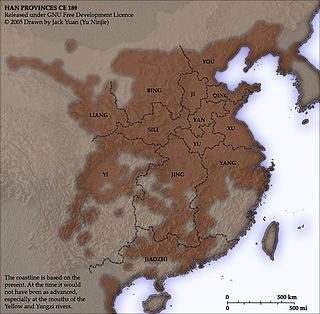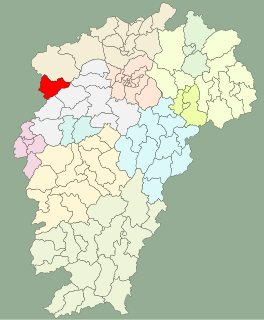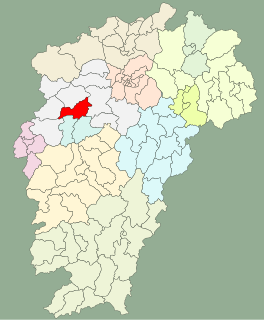
Jiujiang, formerly transliterated Kiukiang or Kew Keang, is a prefecture-level city located on the southern shores of the Yangtze River in northwest Jiangxi Province, People's Republic of China. It is the second-largest prefecture-level city in Jiangxi province after the provincial capital Nanchang. Jiujiang literally means "nine rivers".
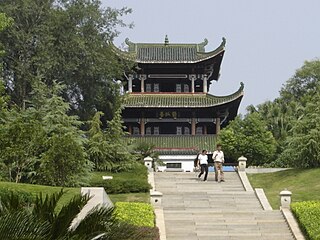
Ganzhou, formerly romanized as Kanchow, is a prefecture-level city in southern Jiangxi, China, bordering Fujian to the east, Guangdong to the south, and Hunan to the west. Its administrative seat is at Zhanggong District. Its population was 8,361,447 at the 2010 census whom 1,977,253 in the built-up area made of Zhanggong and Nankang, and Ganxian largely being urbanized.

The history of Jiangxi stretches from Lower Paleolithic times to the present, as Jiangxi was already inhabited by humans one million years ago. Until recently, the earliest known Jiangxi pottery was dated to around 11000 BC,; however, recent finds show that the absolutely earliest known pottery, from ca. 18,000 BC, comes from Jiangxi In this Chinese province the full Neolithic period began before 8000 BC, as represented by Xianrendong culture in discovering cultivated rice over 10,000 years ago. This period is followed by the Bronze Age around 2000 BC, represented by Wucheng culture and Dayangzhou culture, and by the Iron Age prior to 500 BC.

Yichun (Chinese: 宜春; pinyin: Yíchūn; Wade–Giles: I2-ch'un1; postal: Ichun) is a mountainous prefecture-level city in western/northwestern Jiangxi Province, China, bordering Hunan to the west. Yichun literally means "pleasant spring". It is located in the northwest of the province along a river surrounded by mountains. Yichun has a history of over 2,200 years. It was established in 201 BC during the Han Dynasty. Yichun has a profound Buddhist culture. "Can Lin Qing Gui", the monastic rules for Buddhists at the Buddhist temple, originated from Yichun. Yichun is also the birthplace of a number of literary figures, such as Tao Yuanming and Deng Gu, both of whom are poets from ancient times.

Pingxiang is a medium-sized prefecture-level city located in western Jiangxi province, People's Republic of China.
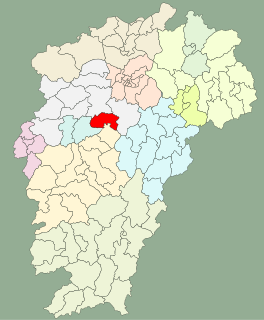
Zhangshu, formerly Qingjiang County (清江县), is a county-level city under the administration of the prefecture-level city of Yichun, in the west-central part of Jiangxi Province. It has an area of 1,291 km2 (498 sq mi) with a population of 536,500. It is the first county of China Top 100 County in Jiangxi Province. The literal translation of the name is Camphor laurel, because traditionally, the city was a major commercial hub for camphor laurel oil. Zhangshu is famous for Chinese medicinal herbs. What's more, the China top 10 medicine producer Renhe Group is located there.Officially, it is the Medicine Capital of China, and there are thousands of pharmaceutical companies. Hundreds of thousands of kinds of Chinese herbal medicines are saled by bulk or by retail.

Fengcheng is a county-level city in northern Jiangxi province, People's Republic of China, under the administration of Yichun, located along China National Highway 105 and on the eastern (right) bank of the Gan River about 55 kilometres (34 mi) south of Nanchang, the provincial capital. The literal translation of the name is "Abundance City", due to its importance as a major commercial hub for agricultural products. There are 26 towns and 7 sub-districts comprising a total area of 2,845 square kilometres (1,098 sq mi) and its population is around 1,370,000. The 2005 GDP was more than 9.1 billion RMB.

De'an is a county under the jurisdiction of the prefecture-level city of Jiujiang in the north of Jiangxi Province, China. Its total area is 939.40 km2 (362.70 sq mi), and the population is 166,000 as of 2010.
Lin Shihong (林士弘) was an agrarian king who rose against the rule of the Chinese Sui Dynasty near the end of Emperor Yang's reign. For several years, he controlled most of modern Jiangxi and Guangdong, but was then under attack by others, gradually reduced to fighting a guerrilla war against Tang Dynasty. He died in 622, and his followers scattered.
Tengwang Ge Xu, full name Preface to a farewell feast atop the Prince of Teng's Pavilion in Autumn or Preface to Poems on the Prince of Teng's Pavilion, is a piece of literature by Wang Bo of the Tang Dynasty. It is considered a founding piece of Tang Literature.
Nanchang (南昌) is the capital of Jiangxi Province, China
Nanchang County is a county in the north of Jiangxi province, People's Republic of China and is under the administration of the prefecture-level city of Nanchang, the provincial capital.
Jinxian County is a county in the province of Jiangxi in the People's Republic of China. It lies in the prefecture of Nanchang.
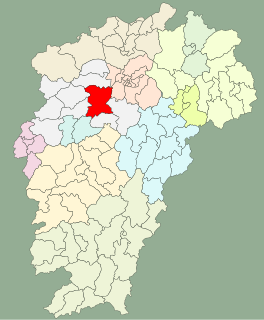
Gao'an is a county-level city in the northwest-central part of Jiangxi province, China. It is under the jurisdiction of the prefecture-level city of Yichun, and is located about 35 kilometers west from Nanchang, the provincial capital. It covers an area of 2439.33 square kilometers and has an estimated population of 1 million people. In 1993, it became a city comprising 20 smaller towns. It is well known for calligraphy and a thriving ceramics industry.

Jiangnanxidao was a southern circuit of Tang Empire. It corresponds to part of present-day Jiangxi, Hubei, Hunan, Anhui. Jiangnanxidao is the origin where the name "Jiangxi" derives from, and its administrative territories also roughly represent nowadays Gan-speaking areas in China.
Gongqingcheng is a sub-prefecture-level city in northern Jiangxi province, People's Republic of China, established on 10 September 2010. It was formerly under the administration of Jiujiang City, the downtown 55 kilometres (34 mi) to the northeast, and is located 62 kilometres (39 mi) north of Nanchang, the provincial capital; on 1 July 2014, it was re-designated as being directly administered by the province, i.e. a sub-prefecture-level city. Situated in the vicinity of De'an, Yongxiu, and Xingzi Counties, it lies in the foothills of Mount Lu and lies on the western shore of Poyang Lake. With an area of 193 square kilometres (75 sq mi), it is home to 120,000 people, including 68,000 permanent residents. There are plans for the city to expand the population to 400,000 people. It is the only city in China to be named after the Communist Youth League of China, which in Chinese is abbreviated to "共青团"; hence its name literally means "Communist Youth League City".
